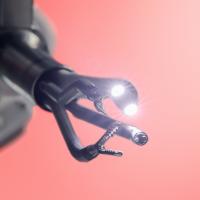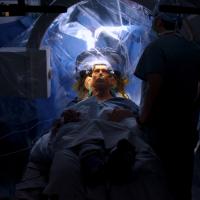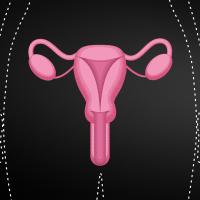For a patient facing an operation, the thought of surgical robots might seem intimidating at first. But some of the world’s top surgeons count on this technology — and it’s making procedures much less invasive.
Surgical robotic systems are becoming more and more widely used to perform a range of surgeries, from prostate to colorectal to thoracic surgeries. This advanced technology has the potential to result in shorter hospital stays and decreased recovery time for patients, unlocking a new era in health care.
Surgery Is Going Robotic
The use of robotic technology has some compelling benefits for both the surgeon and the patient when compared with traditional open surgery. For patients, robotic surgery can mean less blood loss, less pain, and a decreased risk of infection — all of which can make a full return to their normal routine easier.
Surgical robotic systems, such as the da Vinci surgical system, allow doctors to get the same job done with smaller incisions than what is traditionally required. These advanced systems use small instruments with a greater range of motion than human hands, to help doctors achieve high levels of precision and have easier access to the area being operated on. They’re also equipped with a high-definition camera that provides a magnified, three-dimensional view of the surgical site.
But it does take some time for surgeons to get comfortable using these tools, rather than their hands. Intuitive, the company behind the da Vinci surgical system, provides robust training so surgeons can get familiar with all facets of the system.
How Doctors Learn to Use Surgical Robots
Intuitive has been leading the charge in pairing human ingenuity with technology in the medical field since 1995. In addition to creating advanced robotic systems, the company provides rigorous training and surgeon-based proctoring programs for the surgeons who use them.
When Dr. Mary Maish took over thoracic surgery for a small town hospital, her goal was to revolutionize the kind of care that patients would receive. Implementing surgical robotic systems was key to making that a reality.
“The idea of bringing into my practice yet another surgical technique was exciting,” says Dr. Mary Maish, a surgeon at Lake Forest Hospital in Illinois. “But also, it’s a little scary because as surgeons we’re so routine with how we approach things.”
Intuitive’s training curriculum is designed to empower surgeons seeking to transition to robotic-assisted surgery. They’ve empowered Dr. Maish, and over 55,000 other surgeons across the world, to acquire the skills necessary to use robotic systems in the operating room.
Training consists of online learning materials, videos, and live case observations. Surgeons are also invited to practice on a simulator, which recreates a surgery setting in virtual reality. The simulator offers realistic exercises at varying degrees of difficulty so surgeons can practice procedure-specific skills.
At the console, a surgeon uses their hands and feet to manipulate the instruments, which are attached to a cart alongside the patient’s bed.
At the console, a surgeon uses their hands and feet to manipulate the instruments, which are attached to a cart alongside the patient’s bed. The goal is that by the time these surgeons use the system on a real patient, the inputs required at the console can seem almost second nature.
In addition to spending time in a simulated environment, robotic surgeons in training can also work in a training facility with a surgeon experienced using the da Vinci system, who coaches them on best practices. For continued learning, surgeons have the option to pair up with a mentor.
The key to a successful training outcome, according to Dr. Myriam Curet — chief medical officer at Intuitive — is commitment. “As a surgeon, you’re always learning and you’re always improving,” she says. “You have to be willing to practice, get that muscle memory. You have to be willing to learn from your peers.”
Today, Intuitive’s systems have assisted in more than 8.5 million cases. And while their robotic systems certainly deserve a great deal of credit, it’s the company’s ongoing emphasis on education and support for surgeons that makes it all possible.
Robotic surgery can mean less blood loss, less pain, and a decreased risk of infection — all of which can make a full return to normal routines easier.
Dr. Maish experienced all of this first-hand while caring for a patient named Sylvia Dunbeck. After Dunbeck’s initial laparoscopy for lung cancer, she was left with a lengthy recovery time, severe pain, and reluctance to continue on with her next surgery.
But for her second operation, Dr. Maish was able to put her recent training with Intuitive into practice. Using the da Vinci system, she had a greater level of precision and the patient was left with very little pain in comparison to the first operation.
“That gave me the encouragement to continue to march forward in my robotic platform,” Dr. Maish says. Before collaborating with Intuitive, Dr. Maish hadn’t used a surgical robot since medical school.
Patients always hope for fewer nights in the hospital and the ability for life to return to normal as quickly as possible. Surgical robotic systems, combined with trained and confident surgeons, are making this less of an idea and more a reality.
Financial disclosure
Dr. Maish has received compensation from Intuitive for consulting and/or educational services.
The material that is presented in this video represents the views and opinions of independent physicians based on their practice and personal experience using the da Vinci surgical system. The data that will be presented is a single physician experience. The results may or may not be reproducible and are not generalizable.
Surgical risks
Risks associated with pulmonary resection (wedge Resection, segmentectomy, lobectomy) include persistent air leak, pneumonia, prolonged mechanical ventilation > 48 hours, atrial fibrillation, acute respiratory distress syndrome (ARDS), chylothorax, re-intubation, arrhythmias, bronchopleural fistula, phrenic nerve injury, esophageal injury, difficulty breathing, collapsed lung, pulmonary volvulus, and recurrent laryngeal nerve injury leading to vocal cord dysfunction.
Pain outcomes
Statements regarding pain reflect this surgeon or patient’s specific experience and is directional only, not conclusive. Outcomes may not be reproducible or generalizable. Published literature regarding post-operative pain after the robotic-assisted procedure described may be limited and should be reviewed to understand all associated outcomes.
Important safety information
Serious complications may occur in any surgery, including surgery with the da Vinci surgical system, up to and including death. Examples of serious or life-threatening complications, which may require prolonged and/or unexpected hospitalization and/or reoperation, include but are not limited to, one or more of the following: injury to tissues/organs, bleeding, infection, and internal scarring that can cause long-lasting dysfunction/pain.
Risks specific to minimally invasive surgery, including surgery with the da Vinci surgical system, include but are not limited to, one or more of the following: temporary pain/nerve injury associated with positioning; a longer operative time, the need to convert to an open approach, or the need for additional or larger incision sites. Converting the procedure could result in a longer operative time, a longer time under anesthesia, and could lead to increased complications. Contraindications applicable to the use of conventional endoscopic instruments also apply to the use of all da Vinci instruments.
For important safety information, indications for use, risks, full cautions, and warnings please also refer to www.intuitive.com/safety.
Individual outcomes may depend on a number of factors, including but not limited to patient characteristics, disease characteristics, and/or surgeon experience.
Da Vinci Xi/X system precaution statement
The demonstration of safety and effectiveness for the specific procedure(s) discussed in this material was based on evaluation of the device as a surgical tool and did not include evaluation of outcomes related to the treatment of cancer (overall survival, disease-free survival, local recurrence) or treatment of the patient’s underlying disease/condition. Device usage in all surgical procedures should be guided by the clinical judgment of an adequately trained surgeon.
Da Vinci SimNow simulator
The da Vinci SimNow simulator is intended to augment, not replace, existing training programs for the da Vinci surgical systems.
Limitations of training and proctoring
Nothing in Intuitive’s training curricula makes expressed or implied promises or commitments to the persons attending. This includes any promise or commitment that the trainee will be provided any specific product or technology in future or that the trainee will be certified to perform a procedure related to the curriculum.
Some of the training described in Intuitive promotions may be provided by organizations or entities other than Intuitive.
Surgeon proctors are independent contractors. The prices listed for proctoring are for services rendered by the independent surgeon proctors. A list of surgeon proctors can be provided upon request. Intuitive does not take responsibility for proctoring services provided by independent surgeon proctors. The hospital/surgeon purchases the proctoring service as part of training they have independently determined to be part of their credentialing requirement; Intuitive’s role is merely to coordinate between the hospital/surgeon and the proctor. The proctors and the hospital/surgeon are always free to negotiate with each other directly.
Trademark notice
Product and brand names/logos are trademarks or registered trademarks of Intuitive Surgical or their respective owner. See www.intuitive.com/trademarks.
Financial disclosure
Dr. Maish has received compensation from Intuitive for consulting and/or educational services.
The material that is presented in this video represents the views and opinions of independent physicians based on their practice and personal experience using the da Vinci surgical system. The data that will be presented is a single physician experience. The results may or may not be reproducible and are not generalizable.
Surgical risks
Risks associated with pulmonary resection (wedge Resection, segmentectomy, lobectomy) include persistent air leak, pneumonia, prolonged mechanical ventilation > 48 hours, atrial fibrillation, acute respiratory distress syndrome (ARDS), chylothorax, re-intubation, arrhythmias, bronchopleural fistula, phrenic nerve injury, esophageal injury, difficulty breathing, collapsed lung, pulmonary volvulus, and recurrent laryngeal nerve injury leading to vocal cord dysfunction.
Pain outcomes
Statements regarding pain reflect this surgeon or patient’s specific experience and is directional only, not conclusive. Outcomes may not be reproducible or generalizable. Published literature regarding post-operative pain after the robotic-assisted procedure described may be limited and should be reviewed to understand all associated outcomes.
Important safety information
Serious complications may occur in any surgery, including surgery with the da Vinci surgical system, up to and including death. Examples of serious or life-threatening complications, which may require prolonged and/or unexpected hospitalization and/or reoperation, include but are not limited to, one or more of the following: injury to tissues/organs, bleeding, infection, and internal scarring that can cause long-lasting dysfunction/pain.
Risks specific to minimally invasive surgery, including surgery with the da Vinci surgical system, include but are not limited to, one or more of the following: temporary pain/nerve injury associated with positioning; a longer operative time, the need to convert to an open approach, or the need for additional or larger incision sites. Converting the procedure could result in a longer operative time, a longer time under anesthesia, and could lead to increased complications. Contraindications applicable to the use of conventional endoscopic instruments also apply to the use of all da Vinci instruments.
For important safety information, indications for use, risks, full cautions, and warnings please also refer to www.intuitive.com/safety.
Individual outcomes may depend on a number of factors, including but not limited to patient characteristics, disease characteristics, and/or surgeon experience.
Da Vinci Xi/X system precaution statement
The demonstration of safety and effectiveness for the specific procedure(s) discussed in this material was based on evaluation of the device as a surgical tool and did not include evaluation of outcomes related to the treatment of cancer (overall survival, disease-free survival, local recurrence) or treatment of the patient’s underlying disease/condition. Device usage in all surgical procedures should be guided by the clinical judgment of an adequately trained surgeon.
Da Vinci SimNow simulator
The da Vinci SimNow simulator is intended to augment, not replace, existing training programs for the da Vinci surgical systems.
Limitations of training and proctoring
Nothing in Intuitive’s training curricula makes expressed or implied promises or commitments to the persons attending. This includes any promise or commitment that the trainee will be provided any specific product or technology in future or that the trainee will be certified to perform a procedure related to the curriculum.
Some of the training described in Intuitive promotions may be provided by organizations or entities other than Intuitive.
Surgeon proctors are independent contractors. The prices listed for proctoring are for services rendered by the independent surgeon proctors. A list of surgeon proctors can be provided upon request. Intuitive does not take responsibility for proctoring services provided by independent surgeon proctors. The hospital/surgeon purchases the proctoring service as part of training they have independently determined to be part of their credentialing requirement; Intuitive’s role is merely to coordinate between the hospital/surgeon and the proctor. The proctors and the hospital/surgeon are always free to negotiate with each other directly.
Trademark notice
Product and brand names/logos are trademarks or registered trademarks of Intuitive Surgical or their respective owner. See www.intuitive.com/trademarks.


